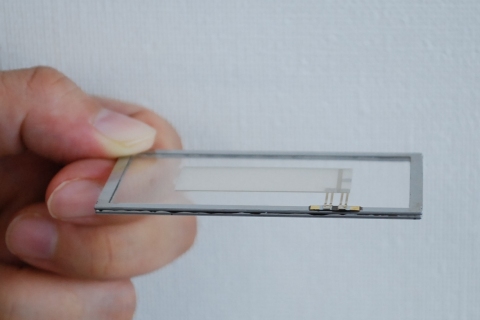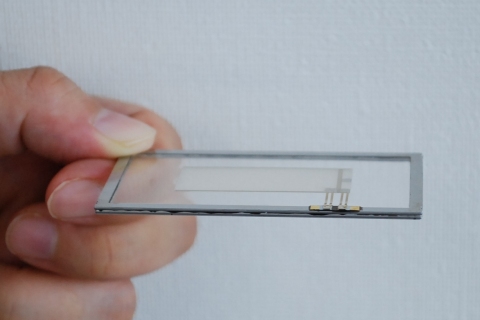KYOTO, Japan--(BUSINESS WIRE)--Kyocera Corporation (NYSE:KYO)(TOKYO:6971) today announced that it has developed an ultra-thin, lightweight (medium-size model thickness: 1mm; weight: 7g) audio device, called “Smart Sonic® Sound.” The new product is based on the company’s long history of pioneering fine ceramic technology and utilizes a piezoelectric actuator combined with a special film to create a piezo film speaker. Smart Sonic Sound will not only contribute to making digital devices even thinner — such as flat-screen TVs, PCs and tablets — but also enhances audio quality for a much more realistic audio experience. Its low directivity characteristics broaden the sound projection range, providing 180-degree sound quality and bringing delicate and minute sounds to life.
This innovative piezo actuator audio technology is being utilized in a flat-screen television for the first time*1 by LG Electronics, Inc. in the company’s new 55” curved-screen OLED TV.
Smart Sonic Sound comes in three different sizes (large, medium and small), and Kyocera plans to expand its use in a broad range of applications including digital devices and automotive applications with strict weight requirements.
This is the second audio innovation from Kyocera in recent years. The company launched the award-winning Smart Sonic Receiver® in early 2012, revolutionizing how sounds are heard exclusively on Kyocera mobile phones for the Japan and U.S. markets. Smart Sonic Receiver uses a ceramic actuator to send vibrations via tissue conduction and traditional air conduction through display screens without the need for a traditional earpiece or loudspeaker, making it ideal for clear audio in exceptionally noisy environments. The new Smart Sonic Sound technology uses the same base technology but with a different implementation that amplifies air conduction.
Development Background
Currently there is a growing demand for even further downsizing (thickness and weight) of flat-screen TVs, PCs and other digital devices. However, up until now there has been a limit to the achievable thinness of such devices due to the size of conventionally-used cone-shaped electromagnetic speakers, which has confined design and engineering layouts. Furthermore, as organic light-emitting displays (OLED) and 4K high-definition screens create a superior visual experience, it has become necessary for audio technology to rise to new heights as well.
Main Characteristics
1. Ultra-thin, lightweight size allows flexibility in end-product design
The piezo actuator used in the new product was born from Kyocera’s proprietary fine ceramic material technology and lamination technology, combined with a special film. Smart Sonic Sound can create the same audio volume as conventional electromagnetic speakers in just a fraction of the width and weight. This allows for the speaker device to be built onto the front face of an end-product with ease — contributing to flexibility and enhancements in end-product designs.
| Model | Large | Medium | Small | |||
| Size (mm) | 70×110×1.5 | 35×65×1.0 | 19.6×27.5×0.7 | |||
| Weight (g) | 23g | 7g | 1g | |||
| Frequency range | 200Hz - 20kHz | 500Hz - 20kHz | 800Hz - 20kHz | |||
2. Low directivity, and high responsivity create a high-quality audio experience
As the new product’s piezo actuator and film create sound through vibrations, the directivity (directional projection of sound waves) is more balanced than a conventional speaker, meaning that sound quality and volume are delivered almost completely equally within a 180 degree range. Moreover, the high speed of responsivity in the Smart Sonic Sound is able to reproduce delicate and minute sounds such as raindrops and background effects with greater clarity, thus providing an even more realistic audio experience.
3. No rare earth elements used
Electromagnetic speakers use the repulsion force of magnetic fields created between the magnet and coil to produce sound, which is achieved through the use of rare earth elements such as neodymium. Conversely, the core component in the Smart Sonic Sound is made of a piezo actuator (fine ceramics) and resins, so the new product eliminates the use of rare earths.
Kyocera will continue to develop new applications for the use of its piezo film speaker, helping to contribute to the further downsizing of electronic equipment.
Other products using Kyocera piezo actuators
Kyocera has developed a range of piezo actuator products using the company’s proprietary technology. Among the wide range of applications, some notable examples include: actuators*2 for diesel-engine vehicles requiring high reliability; actuators*3 in the world’s fastest inkjet printhead*4 used for on-demand printing applications; as well as Kyocera’s Smart Sonic Receiver.
*1 The world’s first use of a ceramic piezoelectric actuator as the
sound device for a flat-screen television. As of July 31, 2013; based on
research by Kyocera.
*2 These actuators control fuel injection,
thus enhancing fuel efficiency and reducing emissions.
*3 These
actuators are used to control the ejection of ink drops in inkjet
printheads.
*4 As of July 31, 2013; based on research by Kyocera.
“Smart
Sonic” and “Smart Sonic Receiver” are registered trademarks of Kyocera
Corporation.
For more photos and graphics, please visit: http://global.kyocera.com/news/2013/0805_ndit.html
Kyocera Corporation (NYSE:KYO)(TOKYO:6971) (http://global.kyocera.com/), the parent and global headquarters of the Kyocera Group, was founded in 1959 as a producer of fine ceramics (also known as “advanced ceramics”). By combining these engineered materials with metals and integrating them with other technologies, Kyocera has become a leading supplier of industrial ceramics, electronic components, mobile phones, solar power generating systems, printers, copiers, semiconductor packages and cutting tools. During the year ended March 31, 2013, the company’s net sales totaled 1.28 trillion yen (approx. USD13.6 billion). The company is ranked #492 on Forbes magazine’s 2013 “Global 2000” listing of the world’s largest publicly traded companies.




